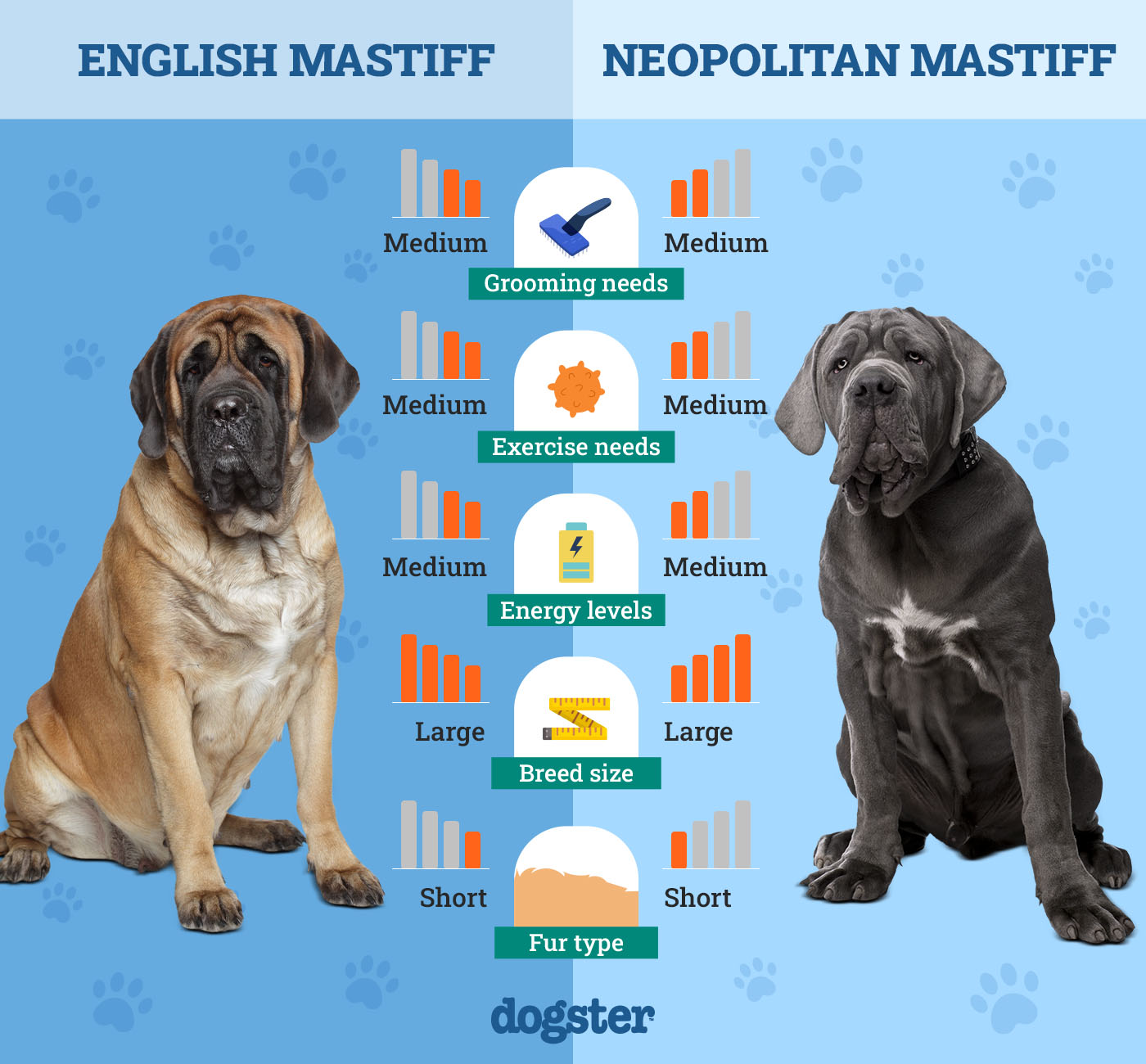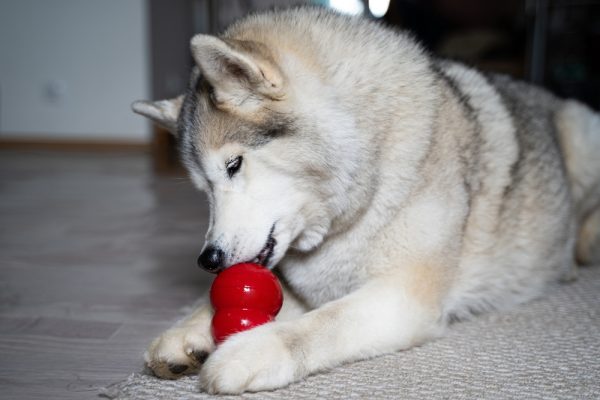In this article
Despite their appearance, the English Mastiff and Neapolitan Mastiff are considered gentle canines in the giant breed class of dogs. Apart from their size, they share a few similar traits that make them popular companions for giant dog lovers.
However, their differences set them apart, and if you are a giant breed lover looking for your next companion, we’ll compare their differences and care needs in this article, so you are equipped with everything you need to know.

Visual Differences

At a Glance
- Average height (adult): 27–30 inches
- Average weight (adult): 120–230 pounds
- Lifespan: 6–10 years
- Exercise: 30–45 minutes a day
- Grooming needs: Moderate
- Family-friendly: Yes
- Other pet-friendly: Often
- Trainability: Easy to train, eager to please
- Average height (adult): 24–31 inches
- Average weight (adult): 110–150 pounds
- Lifespan: 7–9 years
- Exercise: 30–45 minutes a day
- Grooming needs: Moderate
- Family-friendly: Yes
- Other pet-friendly: Often
- Trainability: Strong-willed and independent

English Mastiff Overview

As you know, the English Mastiff is a giant breed, but what you may not know is that it comes with a rich history of guardianship and hunting in Europe dating as far back as 2500 BCE. Today, the Mastiff is still a popular breed, and their history as loyal guardians remains. The combination of their lovable and docile nature, along with their willingness to protect, make them incredible companions.
Personality and Temperament
Despite their immense size, the English Mastiff is a gentle dog with minimal energy needs. It will happily loaf on the couch with its owner, lapping up cuddles. They are generally quiet and calm, but make no mistake, they will be on high alert and jump to action if they perceive any threat to their home and family.
Their gentle temperament makes them great companions for families with children, given that the owners are experienced with large dogs and know their boundaries. They also get along with other pets, especially when brought up together.
Diet
Like all dogs, your English Mastiff will require a well-balanced, high-quality diet that suits its size and life stage. The best way to ensure your Mastiff is on the best diet is by consulting your veterinarian. Generally, a commercial large-breed food approved by the Association of American Feed Control Officials (AAFCO) should be sufficient.1
Because English Mastiffs are deep-chested and prone to gastric dilatation and volvulus (GDV) and bloat, it’s important not to feed your Mastiff with elevated bowls, avoid exercising after meals, and split their diet into 2–3 meals rather than one large meal a day.

Training and Exercise
Compared to other large dogs, English Mastiffs don’t require much exercise. However, like all dogs, daily exercise is essential. A daily walk and some playtime in the park or yard will suffice. They will need about 30–45 minutes a day, which can be broken up into two sessions if necessary.
You need to be cautious about over-exercising a Mastiff puppy and prevent them from jumping from high elevations or running up and down stairs. Early training and socialization are essential, especially with an English Mastiff, since they can be wary of strangers. Early socialization will help them get accustomed to other dogs and strangers, and early obedience training will teach them to obey basic commands such as “sit” and “stay.”
Like all dogs, they respond well to positive reinforcement. They are fast learners and very willing to please, so as long as sessions are short and fun, they will be relatively easy to train.
Health & Care ❤️
As a giant breed, the English Mastiff has a shorter lifespan than smaller dogs. They can live between 6–10 years if well cared for. When looking for an English Mastiff puppy, be sure to find a reputable breeder that has screened their pups for common health issues to which the breed is predisposed. These predisposed health issues include allergies, hip dysplasia, heart disease, cancer, degenerative myelopathy, eye issues, epilepsy, and GDV.
To help your Mastiff live a long and healthy life, ensure that you take it for annual check-ups so that any disease or health issues can be picked up early. If your dog seems unwell or is acting out of sorts, get it to the vet immediately. Ensure you maintain its vaccine schedule and tick, worm, and flea preventatives to reduce health risks as much as possible.

Grooming ✂️
The English Mastiff’s coat is dense and short, does not shed excessively, and doesn’t require intense grooming. Weekly brushing can help reduce shedding, with extra brushing during months of heavier shedding, and a bath is only necessary every few months.
The most attention this breed will need concerning grooming is their drooling. They can be excessive droolers, so it’s handy always to have a cloth nearby. Their facial folds should be kept clean by wiping them daily with a pet-friendly wet wipe to avoid moisture build-up. Owners will also need to monitor their eyes as they are prone to eye issues and contact their vet if their dog’s eyes change.
Suitable For:
The calm and docile nature of the English Mastiff makes it a lovable companion for most families, but their commitment shouldn’t be taken lightly. They are great for families with children. However, caution needs to be taken with very small kids that may get knocked over unintentionally due to their large size.
Early training and socialization will help them grow up to be well-rounded and well-mannered dogs to suit families with children and other pets, and they will require a patient and experienced owner. English Mastiffs also make incredible watchdogs and talented therapy dogs.
They don’t require much exercise, so they will suit apartment living, given there is sufficient space and they are taken out daily for a walk. An English Mastiff owner must consider their budget since they will require a lot more food than a smaller breed.
- Docile and calm
- Lovable and affectionate
- Make great watchdogs
- Low exercise needs
- Eager to please
- Easy to train
- Known to be excessive droolers
- Prone to a few health issues
- May be too large for very small kids

Neapolitan Mastiff Overview

The history of the Neapolitan Mastiff is as rich as its English counterpart. They lived in Italy and served as guardians and dogs of war, and even though their history included fighting in battle, today, they are known to be gentle pups that are happiest at home with their beloved humans.
Personality and Temperament
Despite their large size, they are almost cat-like in their behavior. They are happy to roam around the yard and will likely spend most of their day lounging in the house; it’s safe to say they are a surprisingly lazy breed. They share an unending love for their family and will stop at nothing to protect them.
They can be wary of strangers, but after some time, they will welcome them in as long as their owners approve of them. The Neapolitan Mastiff makes an excellent gentle companion for most families, and they have a lot of love to give.
Diet
Being a large breed dog, the Neapolitan Mastiff will need a sufficient diet to keep it healthy and happy. Its diet should be high-quality, well-balanced, and breed and life-stage-appropriate.
Foods that are formulated for large breeds generally include joint supplements, which are necessary for a large dog like the Neapolitan Mastiff. These include commercial foods approved by the Association of American Feed Control Officials (AAFCO), but it is always best to consult your veterinarian, who can recommend the best diet and guide you with portion sizes.
It is recommended to feed your Neapolitan Mastiff adults two meals a day and puppies 3–4 meals a day. Do not allow your Mastiff to free-feed, as it can easily lead to obesity, which is especially problematic in large breeds. Consider using a slow feeding bowl to prevent your Mastiff from eating too fast and to avoid bloat.

Training and Exercise
While the Neapolitan Mastiff prefers to lay in the sun all day, it will require at least 30–45 minutes of exercise daily. A short walk twice a day and a few play sessions will be enough to keep them fit. However, you must be cautious in warmer weather since they can easily overheat. Also, be careful of high jumps and running up and down stairs.
Early training and socialization are essential for all dogs, especially a large breed like the Neapolitan Mastiff that is wary of strangers. The best training method for your Mastiff is positive reinforcement and to keep sessions interesting but short. However, training this giant breed will also take patience since they are strong-willed and have an independent streak.
Health & Care ❤️
The lifespan of the Neapolitan is slightly shorter than the English Mastiff, 7–9 years, and just like its counterpart, it is prone to some health issues that its pet parents should be aware of.
Health issues include heart disease, GDV, allergies, elbow and hip dysplasia, and cherry eye.
Discussing these health concerns with your breeder and ensuring they have screened their dogs is important.
Also, maintaining annual check-ups with your veterinarian and using preventative treatments for fleas and ticks will prevention will reduce the chances your dog gets an infection or serious illness.

Grooming ✂️
Your Neapolitan Mastiffs coat will require brushing at least three times a week to help reduce shedding, even though they do not shed excessively. They have sensitive skin, so brushing must be gentle, and they will need a bath at least twice a month.
Like the English Mastiff, the skin folds must be cleaned regularly as they are also known to be droolers. Because the Neapolitan Mastiff is prone to cherry eye, you must monitor its eyes regularly and visit the vet if anything seems unusual.
Suitable For:
Neapolitan Mastiffs make excellent companions for owners looking for a large breed without substantial exercise requirements. They will suit any family prepared for living with a big dog and will be more suitable for children who know how to handle large breeds. The Neapolitan Mastiff will make an excellent guard dog as they are wary of strangers. However, they will require early socialization and obedience training. They can happily live in an apartment if they get a daily walk. Anyone who owns this mighty breed must maintain continuous training; an experienced owner is typically recommended.
- Happiest at home
- Gentle and calm
- Affectionate and loving
- Great watchdog
- Low exercise needs
- Tendency to drool
- Can be challenging to train

Which Breed Is Right for You?

The English Mastiff and the Neapolitan are gentle breeds with unending love and adoration for their owners. Their temperaments are very similar, and they are calm and loving at home but will jump without hesitation if they perceive any threat. However, Neapolitans can be a little more unresponsive than English Mastiffs, but they will both warm up quickly over time.
Generally, English Mastiffs are bigger than Neapolitan Mastiffs, but as far as giant breeds go, this difference in size may be a minor factor in your decision-making, perhaps only when it comes to children or your living space. They are both low-energy dogs that require a similar amount of exercise but need a nutritious diet and minimal grooming.
Neapolitans are a bit more stubborn and require a more experienced owner regarding training. However, both breeds will need consistent training and early socialization.
See also:
- Tibetan Mastiff vs English Mastiff: The Key Differences (With Pictures)
- Caucasian Shepherd vs Tibetan Mastiff: The Differences (with Pictures)
Featured Image Credit: Top – Olga Aniven, Shutterstock | Bottom – Anil Sharma, Pexels



















